- Industries
Industries
- Functions
Functions
- Insights
Insights
- Careers
Careers
- About Us
- Technology
- By Omega Team

Generative AI has rapidly become a groundbreaking tool in the dynamic fields of scientific research and technological innovation. This technology is transforming approaches to complex problems and enabling the creation of novel solutions. From enhancing drug discovery processes to revolutionizing climate modeling, generative AI is increasingly recognized as an indispensable collaborator within the scientific community. This article delves into the diverse roles of generative AI in science, exploring its applications, challenges, and prospects.
Understanding Generative AI
Generative AI
This refers to a specific subset of artificial intelligence that focuses on generating new data or content. Unlike other types of AI, which might be designed for tasks like classification or prediction, generative AI is oriented toward creativity and creation. Its primary function is to produce outputs that resemble existing examples, whether that’s images, text, music, or other forms of data.
Techniques
Generative AI relies on advanced techniques such as deep learning and neural networks. These are sophisticated mathematical models inspired by the structure and function of the human brain. By using these techniques, generative AI systems can learn patterns and relationships within vast datasets. This learning process enables them to understand the characteristics of the data they’re working with and generate new examples that fit those patterns.
Variants
Generative AI encompasses a variety of different approaches and models. Some of the most well-known variants include:
- Generative Adversarial Networks (GANs): GANs consist of two neural networks, a generator and a discriminator, which are trained together competitively. The generator generates new data samples, while the discriminator evaluates how realistic those samples are. Through this adversarial process, GANs can produce high-quality, realistic outputs.
- Variational Autoencoders (VAEs): VAEs are a type of neural network that learns to encode input data into a lower-dimensional representation, known as a latent space. This latent space can then be used to generate new data samples similar to those in the original dataset. VAEs are particularly useful for generating diverse and realistic outputs.
- Autoregressive models: Autoregressive models, like OpenAI’s GPT series, generate sequences of data one element at a time, with each element conditioned on the previous ones. These models are widely used for generating natural language text and have achieved remarkable results in tasks such as language generation, translation, and summarization.
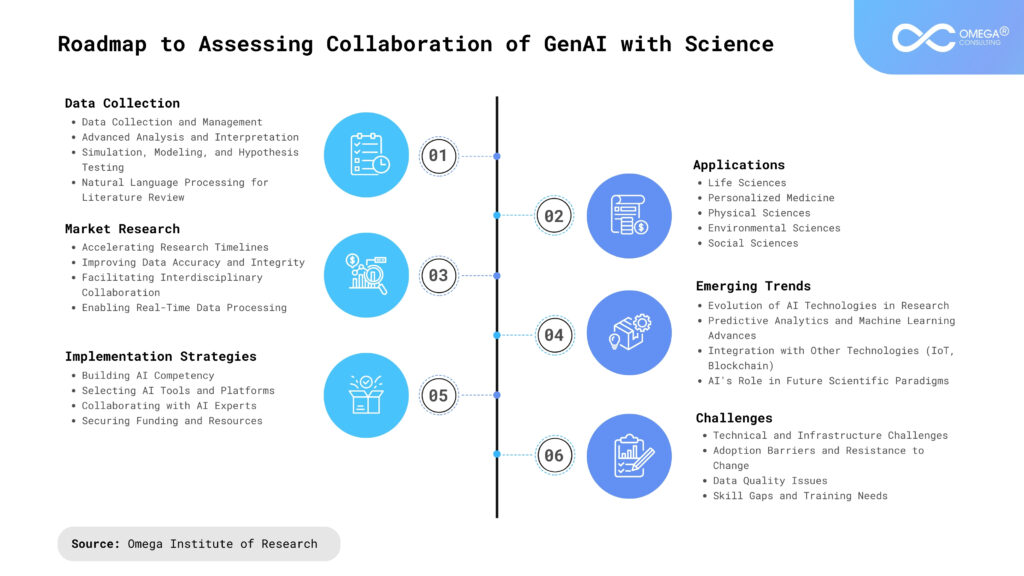
Applications in Scientific Research
Biology
Generative AI plays a crucial role in various areas of biological research. One prominent application is in protein folding prediction. Proteins are complex molecules with unique three-dimensional structures that determine their function. Understanding how proteins fold into their native structures is essential for deciphering their biological roles and designing new drugs. Generative AI algorithms can simulate the folding process and predict the three-dimensional structure of proteins based on their amino acid sequences, aiding drug discovery and personalized medicine efforts.
Moreover, generative AI is instrumental in drug discovery by generating molecular structures with desired properties. By simulating the interactions between drug molecules and biological targets, such as proteins or enzymes, generative models can propose novel drug candidates with optimized efficacy and safety profiles. This accelerates the drug development process and opens up new avenues for combating diseases.
In synthetic biology, generative AI facilitates the design of synthetic biological systems with predefined functions. By generating genetic sequences encoding specific biological functions, researchers can engineer microorganisms to produce biofuels, pharmaceuticals, and biomaterials efficiently. Generative AI enables the exploration of vast sequence spaces and the discovery of sequences with desired properties, revolutionizing the field of synthetic biology.
Materials Science
Generative AI has transformative implications for materials science, particularly in the design of new materials with tailored properties. Materials scientists aim to discover materials with specific characteristics, such as high strength, conductivity, or flexibility, for various applications ranging from electronics to aerospace.
Generative models can simulate the structure-property relationships of materials and predict novel compositions with desired properties. By analyzing vast datasets of material properties and compositions, generative AI algorithms can generate virtual materials with unprecedented combinations of properties, guiding experimental synthesis and accelerating the discovery of advanced materials.
Additionally, generative AI enables the optimization of material processing techniques by predicting the optimal fabrication parameters for desired material properties. This enhances the efficiency of manufacturing processes and facilitates the development of novel materials with superior performance characteristics.
Astronomy
In astronomy, where vast amounts of observational data are collected from telescopes and satellites, generative AI aids in the analysis and interpretation of astronomical phenomena. One significant application is in the detection and characterization of exoplanets, planets orbiting stars outside our solar system.
Generative models can analyze light curves and spectra obtained from telescopic observations to identify signals indicative of exoplanets. By simulating planetary systems and generating synthetic data, generative AI algorithms assist astronomers in distinguishing genuine exoplanet signals from noise and instrumental artifacts, improving the accuracy of exoplanet detection methods.
Moreover, generative AI plays a crucial role in the analysis of gravitational wave data, which provides insights into the dynamics of massive cosmic events such as black hole mergers and neutron star collisions. By generating gravitational waveforms corresponding to different astrophysical scenarios, generative models enable astronomers to infer the properties of gravitational wave sources and probe the nature of spacetime.
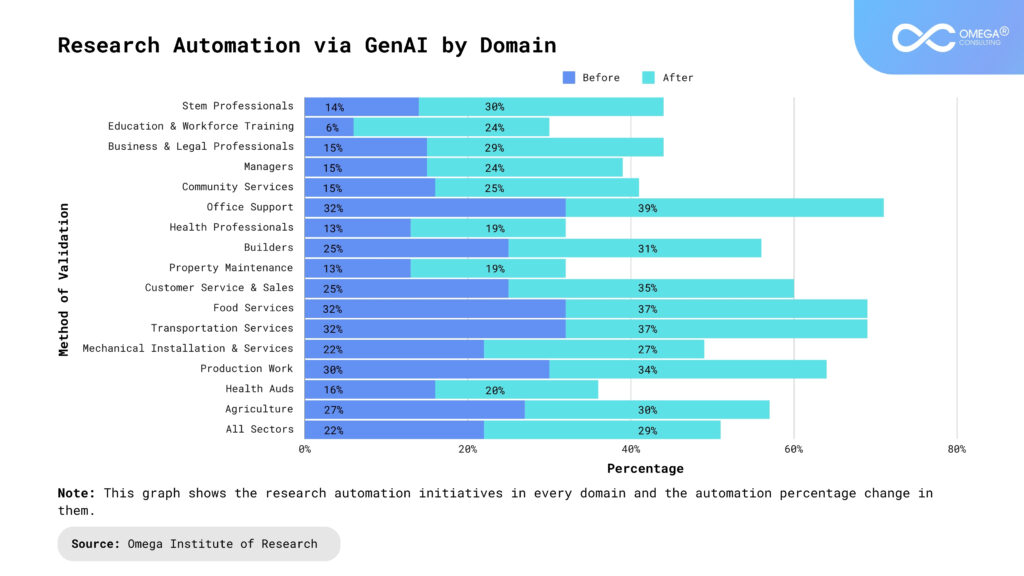
Enhancing Data Analysis
Synthetic Data Generation
Generative AI algorithms can generate synthetic data that closely resembles real-world datasets. These synthetic data samples are created based on the statistical properties and underlying patterns learned from the original dataset. By mimicking the distribution of the original data, generative models produce new samples that capture its characteristics, such as the range of values, correlations between variables, and class distributions.
Overcoming Data Limitations
In many scientific domains, including healthcare, researchers often face challenges related to limited or biased datasets. Small sample sizes, imbalanced class distributions, and privacy concerns may restrict the availability of data for analysis. Generative AI offers a solution to these challenges by generating synthetic data to supplement existing datasets. This augmentation process increases the diversity and size of the dataset, enabling more robust and reliable analyses.
Privacy-Preserving Data Augmentation
In healthcare, patient privacy is of utmost importance, and access to sensitive medical data is tightly regulated to protect patient confidentiality. Generative AI provides a privacy-preserving solution for data augmentation by generating synthetic patient records that preserve the statistical properties of the original dataset without revealing sensitive information. By generating synthetic data that maintains the distribution of medical features while obscuring individual patient identities, researchers can conduct analyses without compromising privacy.
Improving Generalizability
Generative AI enhances the generalizability of data analysis models by creating synthetic samples that represent a broader range of scenarios and variations present in real-world data. By augmenting the dataset with diverse examples, generative models help mitigate the risk of overfitting, where a model learns to memorize the training data rather than generalize to unseen data. This improved generalizability enables more reliable predictions and insights from the data analysis process.
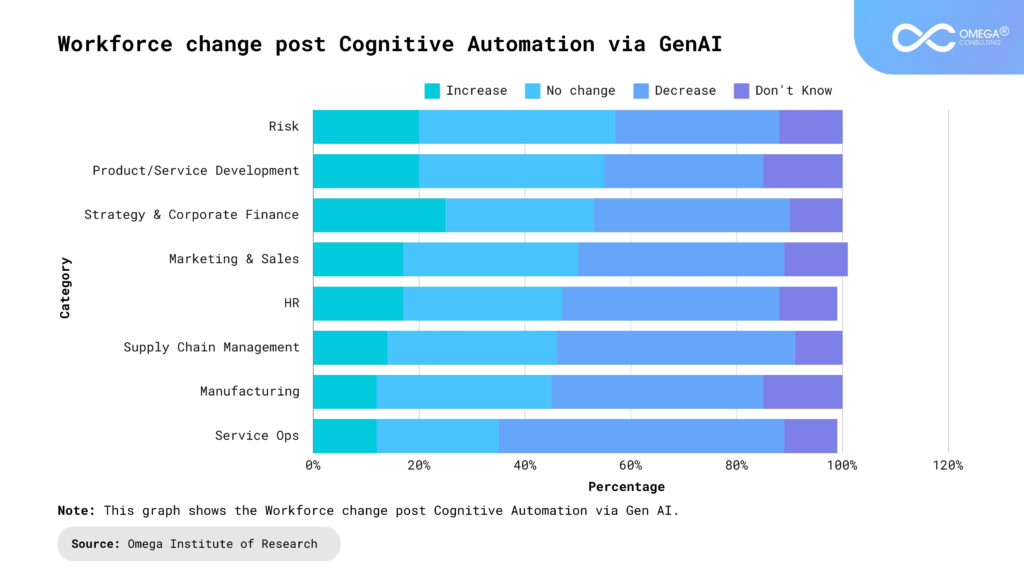
Creativity and Exploration
Simulations and Visualizations
Generative AI enables researchers to create realistic simulations and visualizations of complex systems and phenomena. By leveraging generative models, scientists can simulate the behavior of physical, biological, or social systems under different conditions and scenarios. These simulations provide insights into the dynamics of the systems being studied, allowing researchers to test hypotheses, explore alternative scenarios, and predict future outcomes.
Hypothesis Generation and Exploration
Generative AI algorithms are capable of generating hypotheses and exploring vast solution spaces to uncover novel insights and patterns in data. By analyzing large datasets, generative models can identify hidden correlations, anomalies, or emergent phenomena that may not be immediately apparent to human researchers.
Pushing the Boundaries of Knowledge
Generative AI empowers researchers to push the boundaries of knowledge by facilitating exploration and discovery in scientific domains. By providing tools for creativity and innovation, generative models inspire researchers to think outside the box and pursue new avenues of inquiry that may lead to groundbreaking discoveries.
Overall, generative AI fosters creativity and exploration in scientific endeavors by enabling researchers to simulate complex systems, generate hypotheses, and push the boundaries of knowledge in diverse fields ranging from climate science and theoretical physics to biology and astronomy. As generative AI continues to evolve, it promises to revolutionize scientific discovery and inspire new generations of researchers to explore the mysteries of the universe.
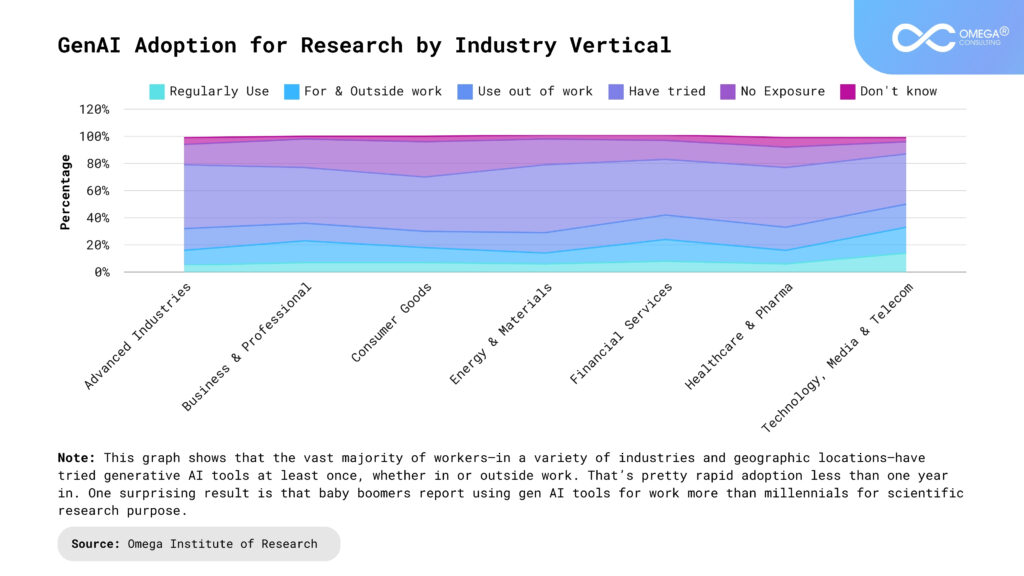
Challenges and Ethical Considerations
Bias in Generated Outputs
Generative AI models can inadvertently learn and perpetuate biases present in the training data. For example, if the training data contains biases related to gender, race, or socioeconomic status, the generated outputs may reflect and amplify these biases. This can lead to discriminatory outcomes in applications such as hiring algorithms, facial recognition systems, and language generation.
Addressing bias in generative AI requires careful attention to the data used for training, as well as the design and evaluation of the models themselves. Researchers must strive to use diverse and representative datasets, employ fairness-aware training techniques, and rigorously assess the performance of generative models across different demographic groups. Additionally, ongoing monitoring and auditing of deployed systems are essential to identify and mitigate bias-related issues in real-world applications.
Misuse and Manipulation
Generative AI technologies, particularly deep learning-based models, can be misused for creating manipulated or synthetic media, such as deepfake videos, audio recordings, and text. These manipulated media can be used to spread misinformation, defame individuals, or manipulate public opinion, posing significant risks to society, democracy, and individual privacy.
Combatting the misuse of generative AI requires a multifaceted approach involving technological, legal, and societal interventions. Technological solutions, such as detection algorithms and watermarking techniques, can help identify and mitigate the spread of manipulated media. Legal frameworks and regulations may be needed to hold individuals and organizations accountable for creating and disseminating malicious deepfakes. Moreover, media literacy initiatives and public awareness campaigns can empower individuals to critically evaluate the authenticity of digital content and combat the spread of misinformation.
Ethical Development and Regulation
Ensuring the ethical development and responsible deployment of generative AI requires the establishment of clear ethical guidelines, standards, and regulatory frameworks. These frameworks should address issues such as data privacy, algorithmic transparency, accountability, and societal impact. Ethical considerations should be integrated into every stage of the generative AI lifecycle, from data collection and model training to deployment and monitoring.
Ethical guidelines can help researchers and practitioners navigate complex ethical dilemmas and make informed decisions about the design and use of generative AI technologies. Regulatory bodies and industry organizations play a crucial role in developing and enforcing ethical standards, fostering transparency and accountability in the development and deployment of generative AI systems. Additionally, interdisciplinary collaboration between technologists, ethicists, policymakers, and affected communities is essential to ensure that generative AI serves the public good and upholds fundamental values such as fairness, justice, and respect for human rights.
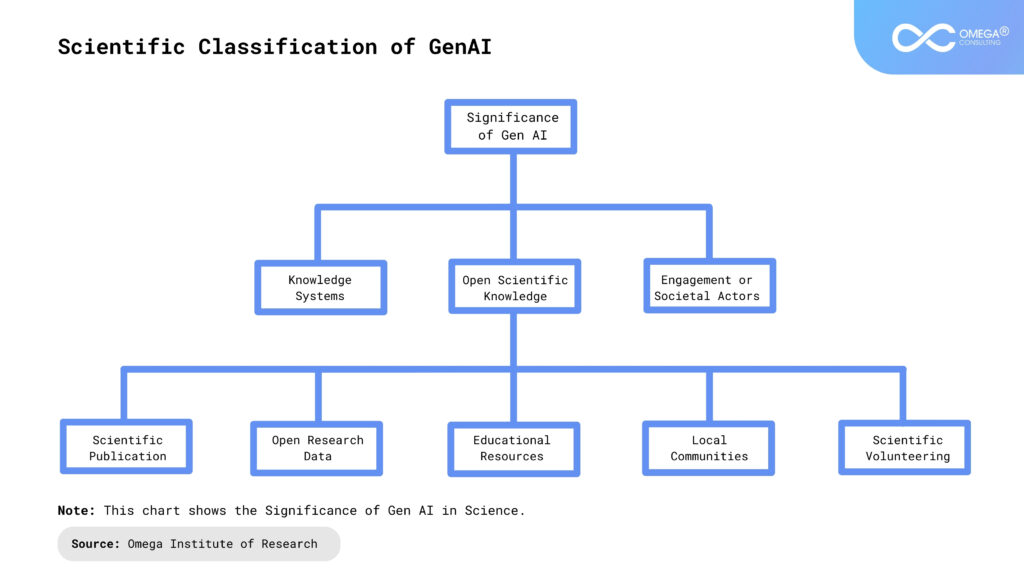
Case Studies
Generative AI is revolutionizing various aspects of US businesses, particularly in fields such as customer service, product development, and marketing. Here are some unique case studies illustrating its impact:
BloomsyBox’s AI-Powered Customer Engagement
BloomsyBox, an eCommerce flower delivery service, integrated Generative AI into their chatbot to enhance customer engagement. During a promotional campaign, the AI chatbot generated personalized greeting cards for Mother’s Day. By engaging users with daily questions and rewarding correct answers, BloomsyBox increased customer interaction and created a memorable gifting experience, showcasing how AI can deepen emotional connections with customers.
Shopify’s Sidekick
Shopify introduced “Sidekick,” a Generative AI assistant designed to support online store owners with various administrative tasks. Sidekick helps with setting up discounts, summarizing sales data, and modifying store designs. This AI tool streamlines operations by providing personalized assistance, allowing business owners to focus on strategic decisions rather than mundane tasks. It exemplifies how AI can act as a co-pilot, enhancing productivity and operational efficiency.
Stitch Fix’s AI for Marketing and Content Creation
Stitch Fix employs Generative AI to create ad headlines and detailed product descriptions. Using AI models like GPT-3, they generate content that matches their brand’s tone and style. This approach not only speeds up content creation but also ensures consistency and quality, with human experts refining the AI-generated outputs. This combination of AI and human oversight demonstrates how businesses can enhance their marketing efforts and maintain brand integrity.
Product Development and Optimization at IBM
IBM uses Generative AI to optimize product design and development. By integrating AI throughout the product lifecycle—from concept to manufacturing—IBM achieves structural optimization, cost reduction, and material efficiency. Additionally, product managers leverage AI to synthesize user feedback, driving improvements based on real user needs. This use case highlights how AI can transform product development processes, making them more efficient and customer-centric.
Generative AI in Project Management
Generative AI tools are being utilized in project management to automate task generation, predict project timelines, and summarize essential business documents. This automation allows project managers to focus on strategic planning rather than routine administrative tasks. By leveraging historical data, AI provides accurate forecasts and enhances decision-making, showcasing its potential to improve project outcomes and efficiency.
Future Directions
Advancements in Model Architectures
Generative AI is poised to benefit from more sophisticated model architectures that generate higher-quality and diverse outputs. Researchers are exploring hierarchical and attention-based models to enhance the flexibility and expressiveness of AI systems. These advancements will allow AI to capture complex patterns and dependencies, leading to more realistic and creative outputs. Moreover, integrating multiple modalities such as text, images, and audio into unified frameworks will open up new possibilities for multimedia generation, storytelling, and human-computer interaction.
Innovations in Training Techniques
Efficient training techniques are crucial for the future of generative AI. Advances in optimization algorithms, regularization techniques, and unsupervised learning will improve the stability, convergence, and generalization of models. Developments in self-supervised and reinforcement learning will enable AI to learn from raw, unstructured data like videos and natural language text, making AI systems more scalable and adaptable.
Interdisciplinary Collaborations
The future of generative AI will be significantly shaped by interdisciplinary collaborations. By combining expertise from fields such as biology, chemistry, physics, and neuroscience, AI researchers can address complex scientific challenges and create domain-specific models. For instance, in drug discovery, collaboration between AI researchers and pharmaceutical scientists could lead to models optimized for generating novel drug candidates with desired properties. Additionally, partnerships with artists, designers, and storytellers can inspire new forms of creative expression, enriching the cultural landscape and advancing our understanding of the creative process.
Ethical and Societal Implications
As generative AI evolves, addressing its ethical and societal implications is essential. Future research must focus on developing ethical guidelines, regulatory frameworks, and governance mechanisms to ensure responsible and ethical use of AI. Increased transparency, accountability, and public engagement are necessary to address concerns related to bias, privacy, security, and accountability. Open dialogue and collaboration among researchers, policymakers, industry leaders, and civil society organizations will help ensure that generative AI benefits society as a whole.
Conclusion
Generative AI is rapidly becoming a vital collaborator in the scientific community, driving innovation and enhancing our ability to tackle complex problems. From revolutionizing drug discovery to advancing climate science, its applications are vast and transformative. However, addressing the associated challenges and ethical considerations is essential to fully realize its potential. As research and development continue to advance, generative AI will undoubtedly play an increasingly critical role in shaping the future of science and technology.
- https://www.vectra.ai/blog/2024-predictions-generative-ais-role-in-cybersecurity
- https://insilico.com/
- https://www.atomwise.com/
- https://www.crowdstrike.com/cybersecurity-101/secops/generative-ai/
- https://insilico.com/platform
Subscribe
Select topics and stay current with our latest insights
- Functions